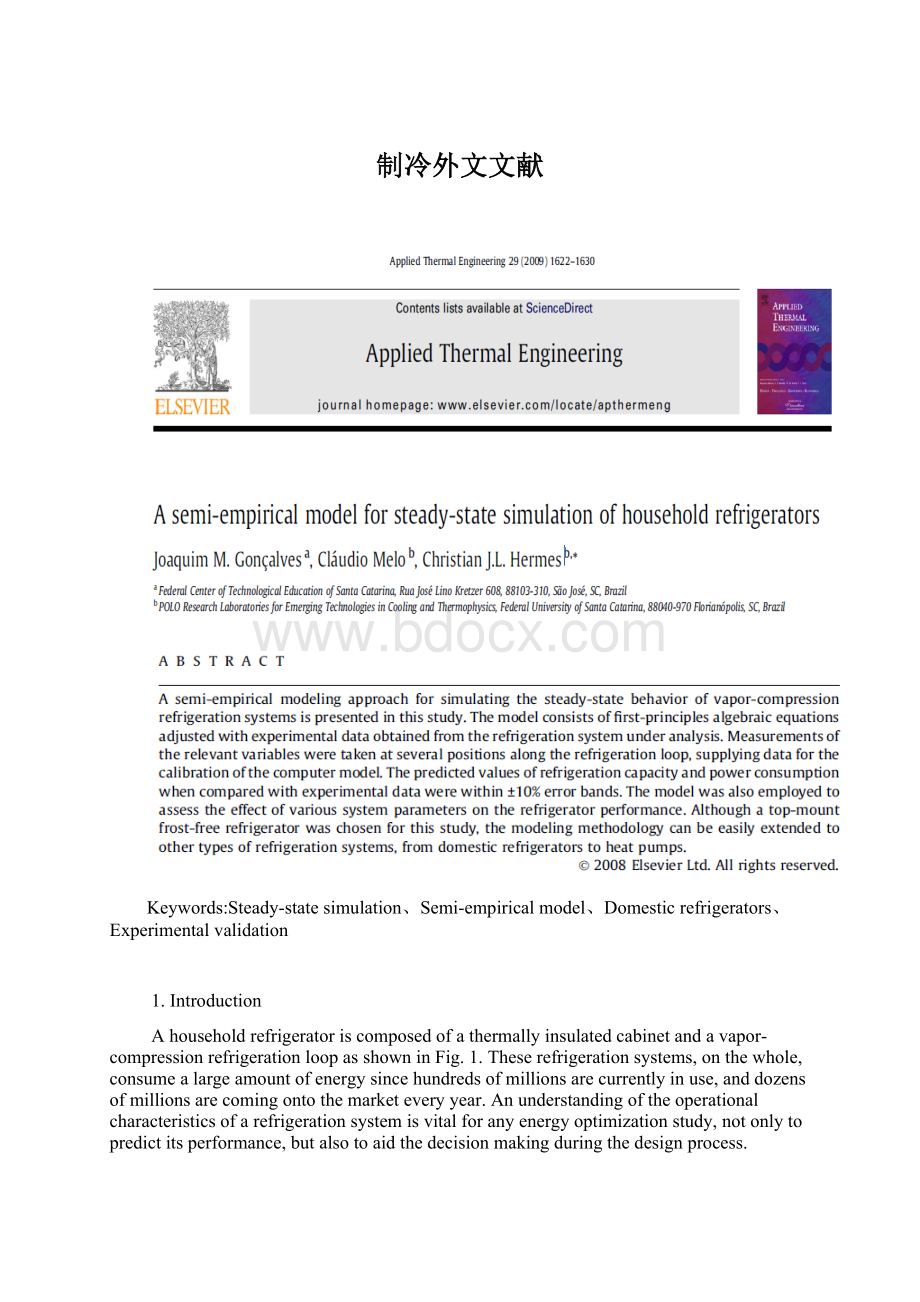制冷外文文献.docx
《制冷外文文献.docx》由会员分享,可在线阅读,更多相关《制冷外文文献.docx(23页珍藏版)》请在冰豆网上搜索。

制冷外文文献
Keywords:
Steady-statesimulation、Semi-empiricalmodel、Domesticrefrigerators、Experimentalvalidation
1.Introduction
Ahouseholdrefrigeratoriscomposedofathermallyinsulatedcabinetandavapor-compressionrefrigerationloopasshowninFig.1.Theserefrigerationsystems,onthewhole,consumealargeamountofenergysincehundredsofmillionsarecurrentlyinuse,anddozensofmillionsarecomingontothemarketeveryyear.Anunderstandingoftheoperationalcharacteristicsofarefrigerationsystemisvitalforanyenergyoptimizationstudy,notonlytopredictitsperformance,butalsotoaidthedecisionmakingduringthedesignprocess.
Therefrigeratorperformanceisusuallyassessedbyoneofthefollowingapproaches:
(i)simplifiedcalculationsbasedoncomponentcharacteristics;(ii)componentanalyzesthroughcommercialCFDpackages;and(iii)standardizedexperiments.Althoughthefirsttwotechniquesplayimportantrolesincomponentdesign,theydonotprovideenoughinformationoncomponentmatchingandsystembehavior,whichisonlyobtainedbytestingtherefrigerator
inacontrolledenvironmentchamber.Thesetests,however,aretimeconsumingandexpensive.Afasterandlesscostlyalternativeistheuseofcomputermodelstosimulatethethermal-andfluid-dynamicbehaviorofrefrigerationsystems.
Manymathematicalmodelshavebeenproposedinthepastforrefrigeratormodeling.Inoneoftheearlieststudies,DavisandScott[1]developedamathematicalmodeltopredictthesteady-statecomponentbehavioroverarangeofoperatingconditions,consistingofindividualcomponentsub-modelsthatcombinedfirst-principleswithanumberofempiricalparametersobtainedfromtheliterature.Simplisticmodelswereusedforheatexchangersastheevaporatingandcondensingpressureswereassumedtobeknown.Thecompressormodel,ontheotherhand,consideredthein-cylindercompressionandthepressuredropsinthesuctionanddischargevalves.Nomodelhasbeenprovidedfortheexpansion
device.
Afewyearslater,theUnitedStatesDepartmentofEnergy(USDOE)sponsoredthedevelopmentofasteady-statesimulationmodelforhouseholdrefrigerators,whichwasintendedtobeadoptedasareferencetoestablishtheenergytargetsforAmericanhouseholdmanufacturers[2].BasedontheUSDOEmodel,severalincrementalstudieswerethencarriedout.First,Abramsonetal.
[3]incorporatedasub-modelforthecapillarytube-suctionlineheatexchanger,andthemodelwasadaptedtosimulateatwo-door‘Combi’refrigerator.Later,Reevesetal.[4]improvedtheoverallcomputationalperformanceusingthee-NTUmethodforheatexchangermodeling,andpolynomialfitsforthecompressormassflowrateandpowerconsumption.
Morerecently,Kleinetal.[5]proposedafirst-principlesmodelforsimulatingthesteady-statebehaviorofa230-lall-refrigerator,whichcomprisedthefollowingcomponentsub-models:
anaturaldraftwire-and-tubecondenser,aplate-type‘roll-bond’evaporator,acapillarytube-suctionlineheatexchanger,ahermeticreciprocatingcompressor,andaninsulatedcabinet.Themodelwasestablishedbasedonthemass,momentumandenergyconservationlaws,heattransferequations,equationsofstateoftheworkingmediaandempiricalcorrelationsderivedfromexperimentaldata.Thecapillarytube-suctionlineheatexchangersub-modelwasderivedfromamoresophisticatedmodel[6]throughafractionedfactorialdesigntechnique,whilstthecompressorsub-modelwasbasedoncurvefittingsofcalorimetricdata.
Inallofthestudiesmentionedabove,themodelsdependedonreliablecomponent-levelperformancedata,whichrequiredpurpose-builtexperimentalfacilitiesfortestingeachcomponent.Inthepresentstudy,therequiredempiricalinformationwasgathereddirectlybytestingtherefrigeratorinacontrolledtemperatureandhumiditychamber.Inordertodoso,therefrigerationsystemwasproperlyandcarefullyinstrumentedtominimizeanyaffectonitsperformance.Theconservationlawswereemployedtoestablishthegoverningequationsthatdescribethesystembehavior.Eachcomponentwasmodeledusingalumpedapproach,basedonphysicalprinciplesandemployingempiricalparameters(e.g.,heattransfercoefficientsandfrictionfactors),adjustedtofittheexperimentaldata.Themodelshowedgoodagreementwithexperimentaldataduringthevalidationexercise.
2.Experimentalwork
Thetestswereperformedwitha430-ltop-mountfrost-freerefrigerator,assembledwithahermeticreciprocatingcompressor,anaturaldraftwire-and-tubecondenser,andatube-fin‘no-frost’evaporator.ThesealedsystememployedHFC-134aastheworkingfluid(130g)andsyntheticoilasthelubricant(250ml).Theairtemperaturesinthefreezerandinthefresh-foodcompartmentswerecontrolledbyathermostatandbyathermostaticdamper,respectively.
Therefrigeratorwasinstrumentedandinstalledinsideanenvironmentchamber.T-typethermocoupleprobeswereimmersedintherefrigerantflowpassageandabsolutepressuretransducerswithameasurementuncertaintyof±0.1%ofthefullscalewereinstalledatsevenpointsalongtherefrigerationloop,asshowninFig.1.ACoriolis-typemassflowmeterwithameasurementuncertaintyof±0.03kg/hwasinstalledatthecompressordischarge.Thesurroundingairtemperaturewasmeasuredbyfivethermocouplesplacedaroundtherefrigerator.Thefreezerandthefresh-foodairtemperaturesweremeasured,respectively,bythreeandsixthermocouplesplacedwithinthesecompartments.AllT-typethermocouplesemployedinthisstudyhaveameasurementuncertaintyof±0.3C.Thecompressorandfanpowerconsumptionweremonitoredusingadigitalpoweranalyzerwithameasurementuncertaintyof±0.1%.A112-channelsystemwasemployedfordataacquisition.Testswereperformedbeforeandaftertheinstrumentationsetuptocheckforanydiscrepanciesinthesystemperformance.
Additionaladjustmentswereintroducedintothesystemtoallowtheobtainmentofthedesiredinformation.Aneedlemeteringvalvewasinstalledasanauxiliaryexpansiondeviceupstreamofthecapillarytube.Theoriginalfixedcapacitycompressorwasreplacedbyavariablecapacitycompressor.Thewallheatloopwasby-passedandthedefrostheaterswereturnedoff.Thethermostatic
mechanismofthedamperwasremovedandtheaperturewaskeptconstantlyopened.Thecompressorandfanpowerconsumptionandspeedwerecontrolledandmeasuredindependently.ThecompressorpowerconsumptionandspeedweremeasuredwithaYokogawaWT230poweranalyzer.Thefanspeedwasmeasuredusinginfraredlight.Intotal,13variableswereexperimentallystudied,sevenweregeometriccharacteristicsofthesystemandtheothersixwereoperationalvariables.
Thegeometriccharacteristicswerevariedindifferentcombinationswhichgeneratedeightdifferentsystemconfigurations,asshowninTable1.Eachconfigurationwastestedcontrollingthefollowingsixoperationalvariables:
(i)ambienttemperature;(ii)compressorspeed;(iii)refrigerantcharge;(iv)auxiliaryexpansiondeviceopening;(v)fanspeed;and(vi)internalheating.Atotalof168testswereperformed,approximately20testsforeachconfiguration.Independentexperimentalsetupswereusedtomeasurethecapillarytubeinnerdiameter,theinternalvolumesofthecomponents,andthecabinetoverallthermalconductance.Therangeoftestedconditionsisshowedinthepressure–enthalpydiagramofFig.2.Itisworthofnotethatthisdatasetcanalsobeusedforcomponentanalysis.
Fig.1.Schematicrepresentationofthevapor-compressionloop.
3.Mathematicalmodel
Formodelingpurposes,therefrigerationsystemwasdividedintofivecomponentsub-models:
(i)compressor,(ii)capillarytube-suctionlineheatexchanger,(iii)condenser,(iv)evaporator,and(v)refrigeratedcabinet.Eachofthecomponentsub-modelsaredescribedbelow.Moredetailedinformationcanbefoundin[7].
3.1.Reciprocatingcompressor
Inmostreciprocatingcompressors,theenteringrefrigerantpassessuccessivelythroughthecompressorshell,thesuctionmufflerandthesuctionvalvetothecompressionchamber,whereitisexpelledthroughthedischargevalvetothedischargemuffler.Thecompressormassflowrateequationwasbasedonthevolumetricefficiency,ƞ
asdefinedby[8]
(1)
wherewandNarethecompressormassflowrate(kgs
)andspeed(s
),respectively,V
isthecompressionchambervolume(m
),andv
isthespecificvolumeatthecompressorinlet(m
kg
).
Thecompressordischargeenthalpy,h
wasobtainedfromanoverallenergybalance
(2)
whereƞ
istheoverallcompressionefficiency.ThecompressionpowerW
wascalculatedasfollows:
(3)
Thecompressorheatreleaseratewascalculatedbyanoverallthermalconductance,UA
relatedtothetemperaturedifferencebetweenthedischargeline,t
andthesurroundingair,t
.
Thecompressorvolumetricandoverallefficiencyvaluesandtheoverallcompressorthermalconductancewereallfittedtotheexperimentaldata,yielding
whereUA
isgivenin(WK
),p
andp
in(bar),t
andt
in(
C),andNin(rpm).AscanbeseeninFig.3,thissetofequationspredictstheexperimentaldataformassflowrate(Fig.3a)andpowerconsumption(Fig.3b)within±10%errorbands,andthecompressordischargetemperature(Fig.3c)withdeviationsof±5
C.
Fig.3.Validationofthecompressorsub-model:
(a)massflowrate,(b)power
consumptionand(c)compressordischargetemperature
3.2.Heatexchangers:
condenserandevaporator
Thecondenserisanaturaldraftwire-and-tubeheatexchanger,inwhichtheair-sidetemperatureisassumedtobeuniform.Thecondenserwasdiv